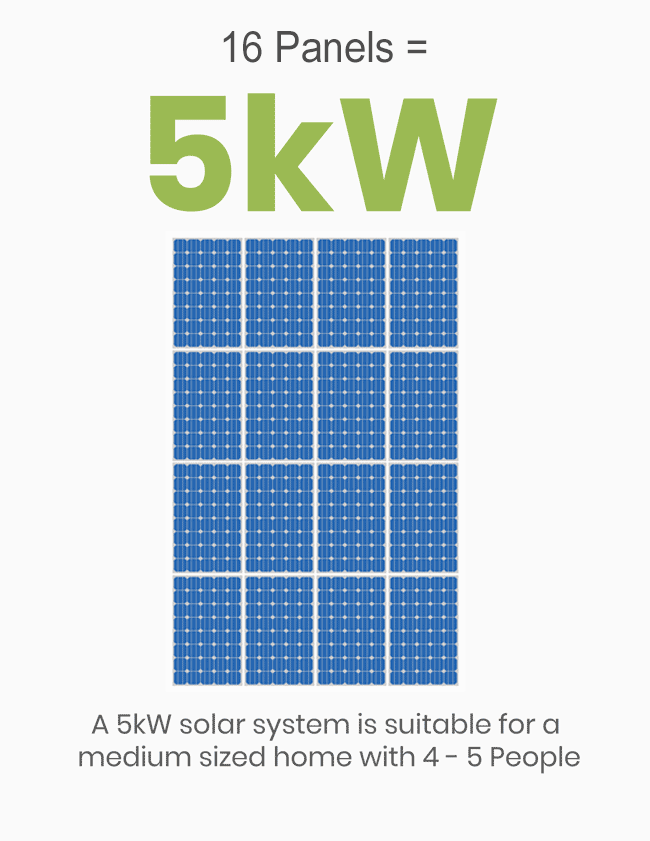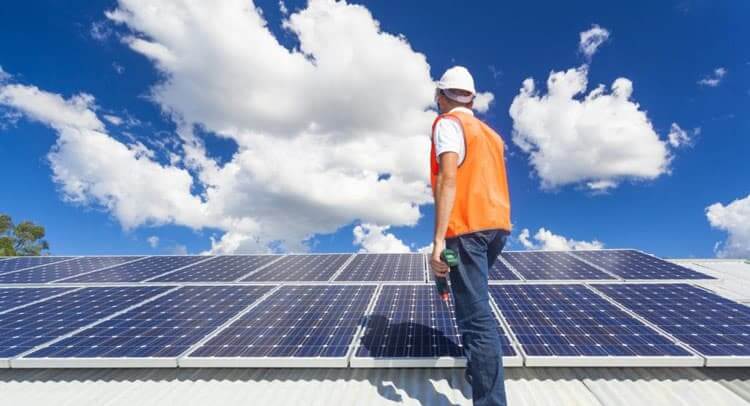Home How Many Solar Panels Do I Need To Power My Home?
How many solar panels do I need to power my home?
The quantity of solar panels needed to power your home depends on the energy usage of your household.
The most common/ popular setup is a 5kW solar system. They require 16 panels to be placed on a north-facing roof.
Below are some insights into choosing the right system for your needs by answering some of the common doubts and questions you might have.

Table of Contents
ToggleHow to calculate number of panels needed
To calculate the number of panels, you need first you need to determine your energy requirements.
Look at your power bill and determine your daily power usage.
1. Take your monthly electricity bill and divide it by 30 to get your daily usage.
2. Look at the table below to see the size of the system you will need.
What Is The Most Popular Solar System Size?
Solar power generation systems come in different sizes starting from 1.5kW to 5kW and even 10kW systems. The most popular system is a 5 kW system and will suit a medium-family home with 3-5 members. It is even capable of delivering this during winter months when you receive a lesser number of daylight hours.
The cost of installing such a system would be in the range of $4,500 – $7000.
Return On Investment: Based on the savings you’d have on your monthly energy bills the system you will be able to recover your investments in 4-5 years.

Is it still worth installing solar panels on my home?
There are a few reasons that are driving people towards solar energy across Australia. First is off is the rapidly rising cost of energy. Most of Australia’s energy companies are foreign-owned, and as soon as they were sold off over a decade ago, the prices started to rise.
The second reason is the very generous rebate most state governments are offering people to install solar. You will save 40 – 50% off installation costs of what other residents are paying in the United States and Germany due to our Awesome government incentives.
Another big one is property value and investment purposes. Just by having a solar system installed (worth about $5,500) adds an average of $29,000 to the value of your home.
The fact that homeowners are seeing the solar system pay for itself in 3-4 years on average means the ROI is even worth it in the long term even if you don’t plan on selling.
Of course, environmental factors such as global warming and people wanting to reduce their carbon footprint also play a role.
What Is The Solar Power Calculation Formula?
To calculate your solar power requirements you can use the below formula –
kWh per month / (Average sunlight per day x 30) = kW solar system
If you’re using 600 kWh per month and reside in an area that gets an average of 5 hours of sunlight per day we come down to a calculation of 600/(5×30) which is 4.00 kW. You should also take into account different kinds of losses which include –
• Battery (Conversion Loss)
• Cables (Transfer Loss)
• Inverter (Conversion Loss)
On average, you can factor in about 20% energy loss due to these three factors and hence if you are looking to generate 4.00 kW of power you need to target a 5.00 kW system.
There are a few other calculations you need to make and now take a look at some of them.
Inverter / UPS
Ideally, you should invest in an inverter that can accommodate more than 25% of your present load considering future needs. Let’s take an example of 2000 watts load.
You will need an inverter 2000 + 2000 x (25/100) = 2500 Watts
Battery Requirement
If you are going to install 24V, 100Ah batteries the calculation would come to –
24V x 100Ah = 2000 Wh
2000 Wh / 2500 W = 48 minutes of backup time
If you need 4 hours of backup time or 240 minutes you will need to install 5 batteries for your system.
How Much Physical Space Will I Need On My Roof?
A single solar panel has a standard dimension of 165cm x 100cm.
Bearing in mind you will need a north-facing roof in Australia to make having solar viable, below is the roof space required for the various system sizes.
Amount of Roof Space Needed
In case you are going for low-efficiency panels, you may need to install as many as 48 of them and in that case, the physical space required on your rooftop would be around 850 square feet.
If I Have More Efficient Panels, Will I Need Less Of Them?
The answer is yes. When you choose more efficient solar panels you will be able to generate the required power using a lesser number of panels. Thankfully solar panels available in the market have become more efficient in recent years. 320 watts-rated efficiency has become almost the norm in the market.
50-watt rated efficiency means that for every 1000 watt of solar power falling on one square meter surface area 250 watt is converted into electrical energy. Hence if you wish to have a 5KW system at your home you will need to install 20 panels.
You will also find cheaper panels that come with lower-rated efficiency and in such cases, you will need to install more number of panels. There are two problems you will encounter with cheaper panels.
First is their quality which often means a reduced service life and secondly, they are likely to occupy more area on your roof where you will have to spend additionally on mounting them.
How Many Solar Panels Can I Have?
As many as you want, but the real question should be how many solar panels you need which we have already answered.
As we have seen above the area available on your rooftop can also determine the number of panels you can install. You should ideally target installing panels that can generate your present needs and also have sufficient headroom to power your needs for the near future.
If your local power company doesn’t allow net metering (which allows you to feed unused power into the grid which they pay you for) you should only target generating enough energy you need to use from day to day.
In case the net-metering option is available, and you have a large roof you can obviously generate more power and monetize it. But as we have mentioned before, an average should target a 5.00 KWH system with about 20-24 panels which are enough to power the needs of the home.
Should I get a battery?
At this stage in early 2020, batteries are still too expensive in my opinion. The fact is companies are paying generous feed-in tariffs back to customers when generating more power than they need which acts as virtual storage.
As battery production increases over the coming 5 years and technology improves, the price falls to less than half making getting a battery much more cost-effective.
Currently, a solar system takes about 3-4 years to pay for itself. Add a battery and that jumps to over 10 years. The irony is 10 years is the expected shelf life of a solar battery so you will be up to replace it right after it paid for itself.
It will be worth waiting a few years and just adding it to your system when it makes sense financially.
Table of Contents
Toggle




